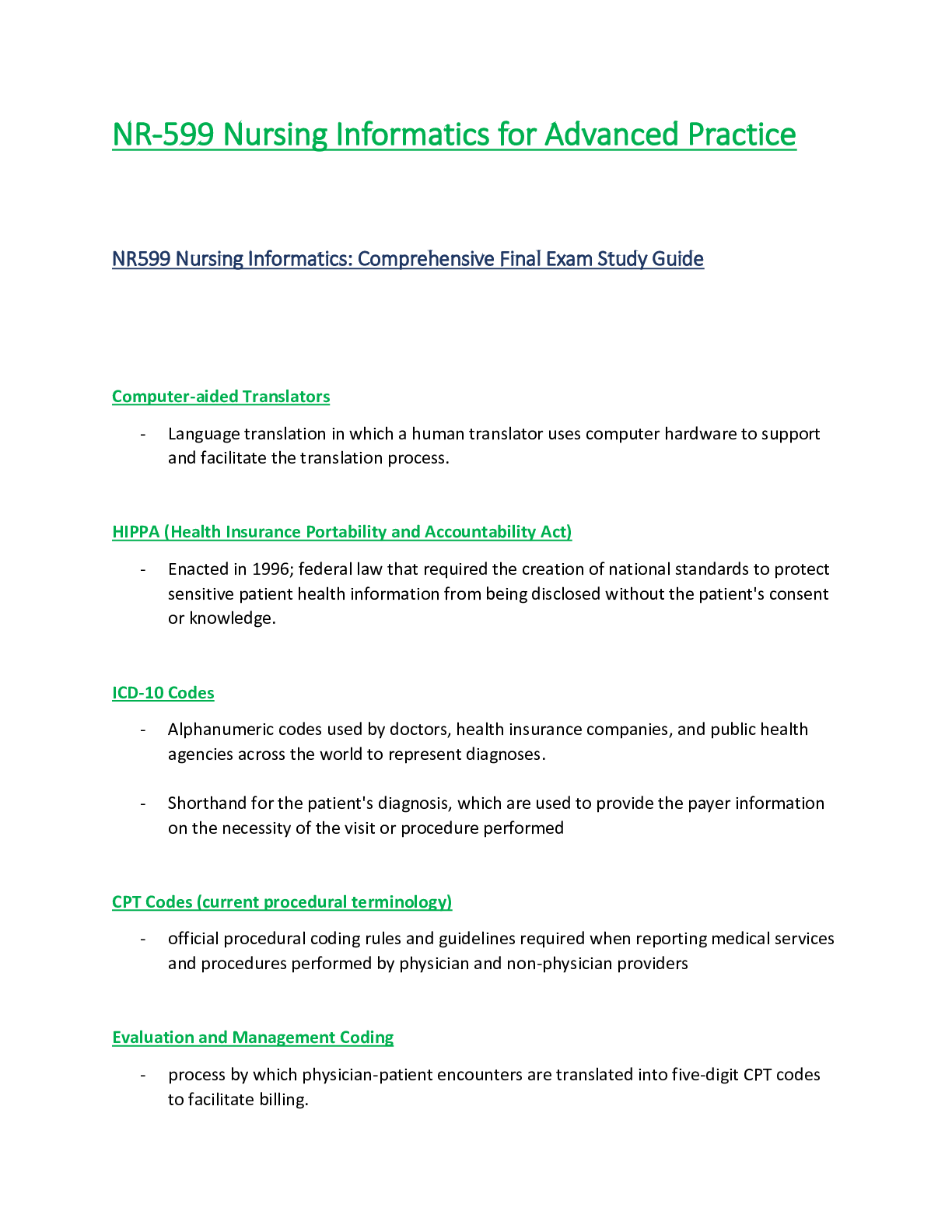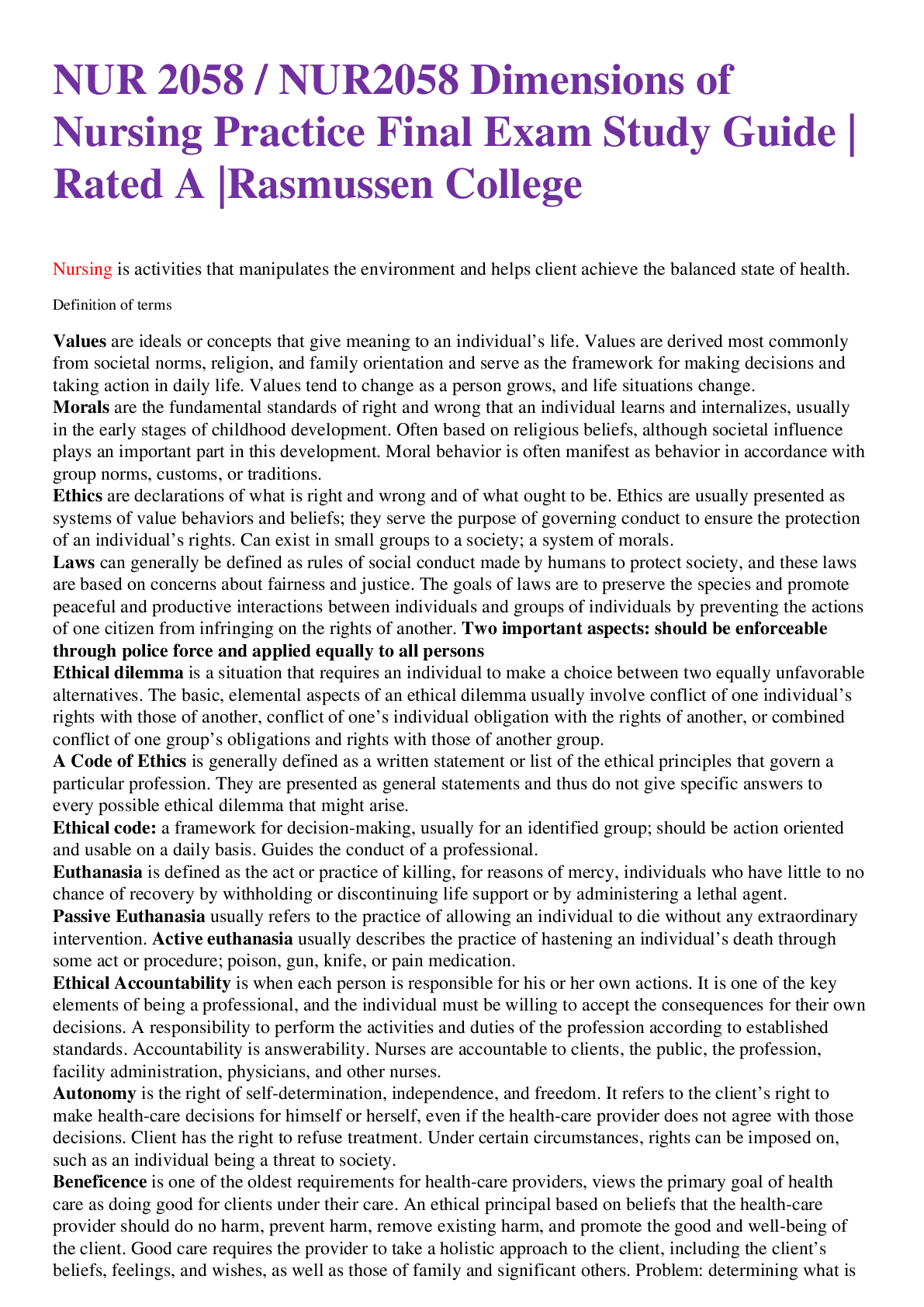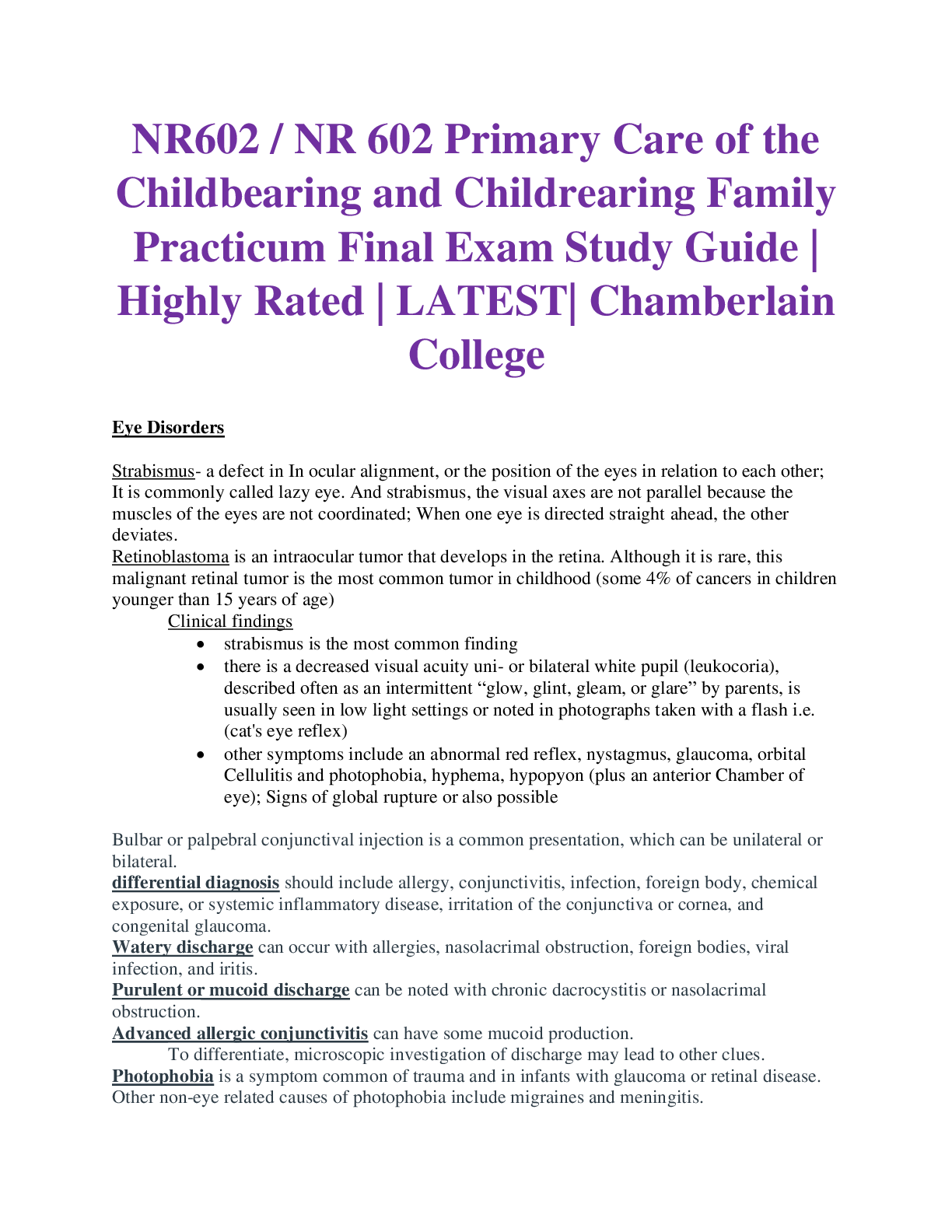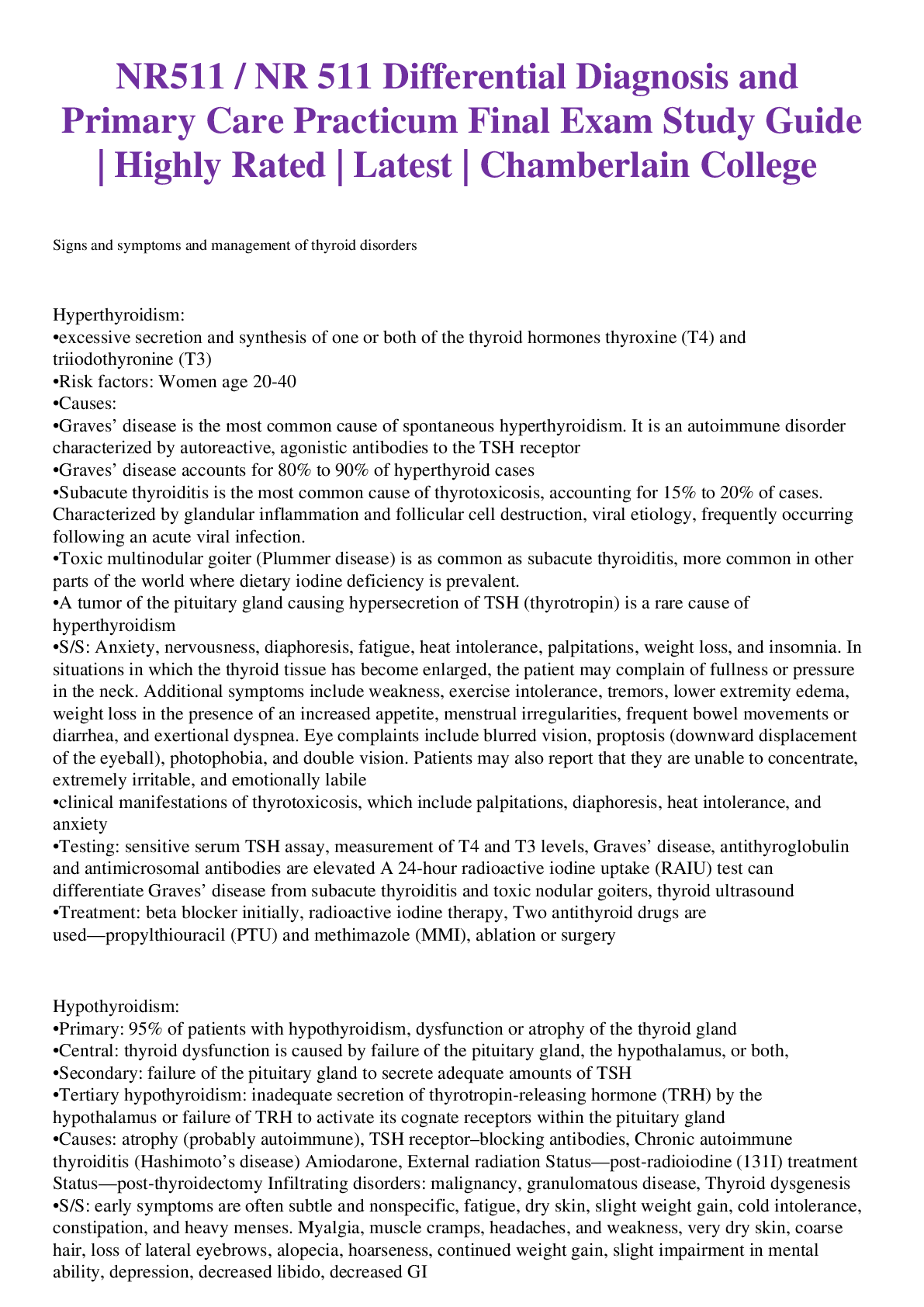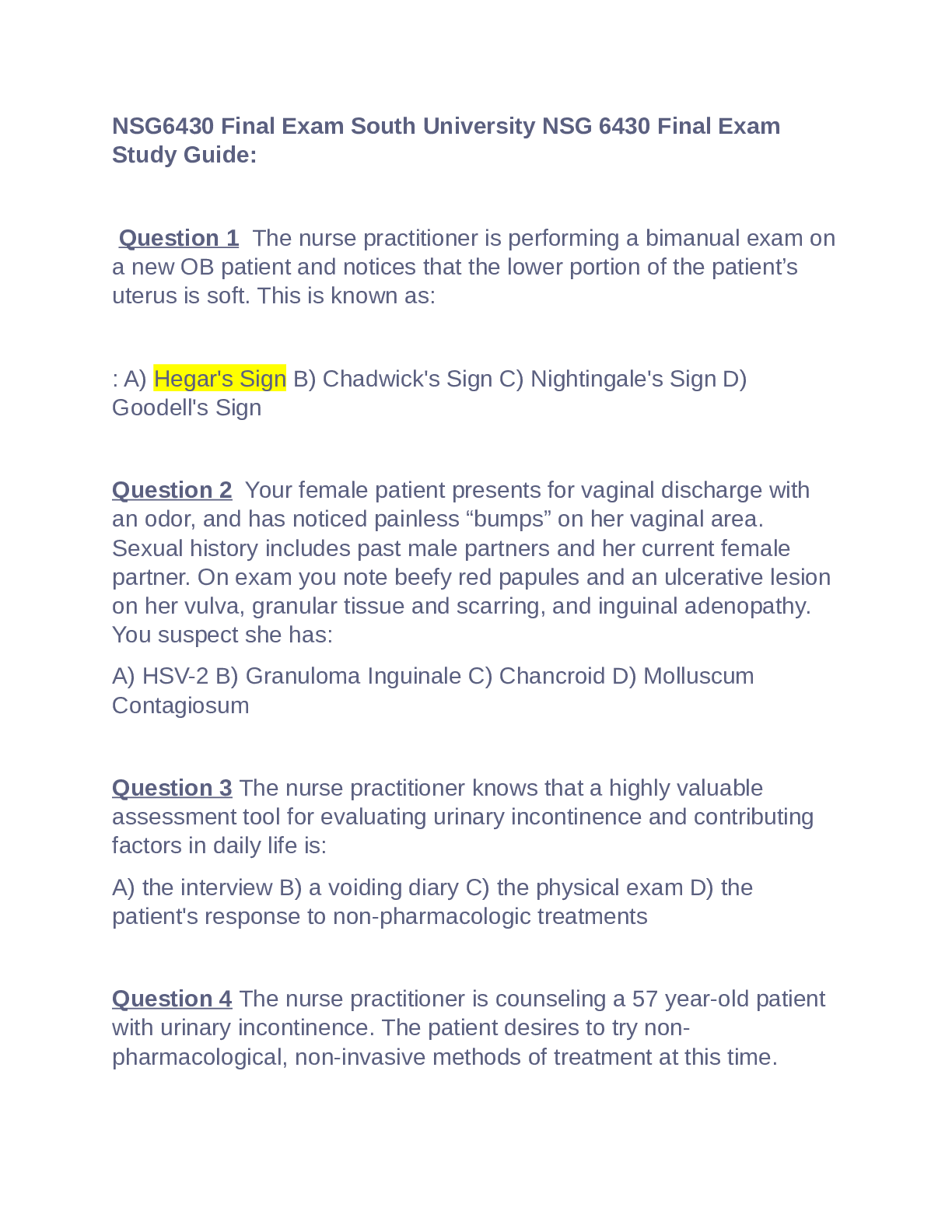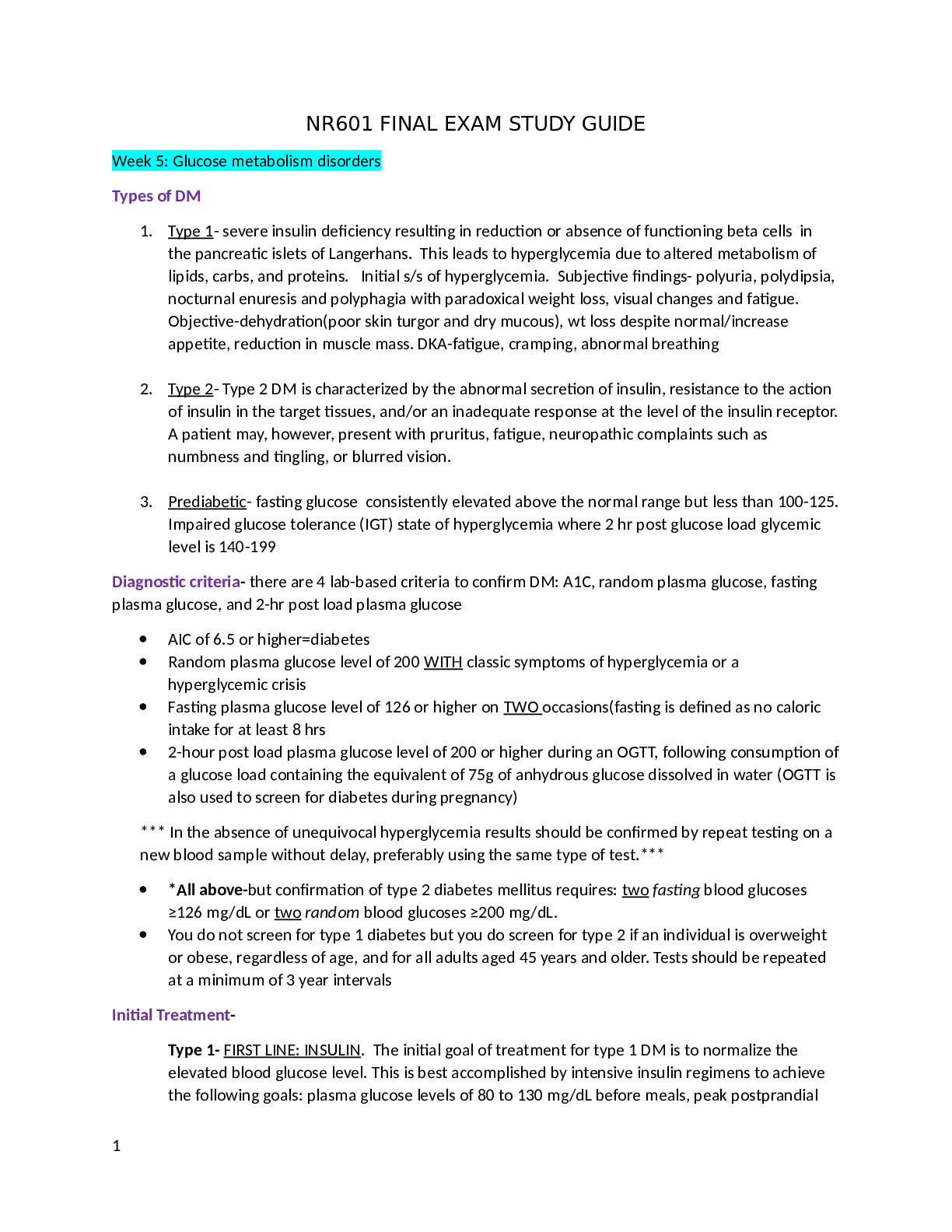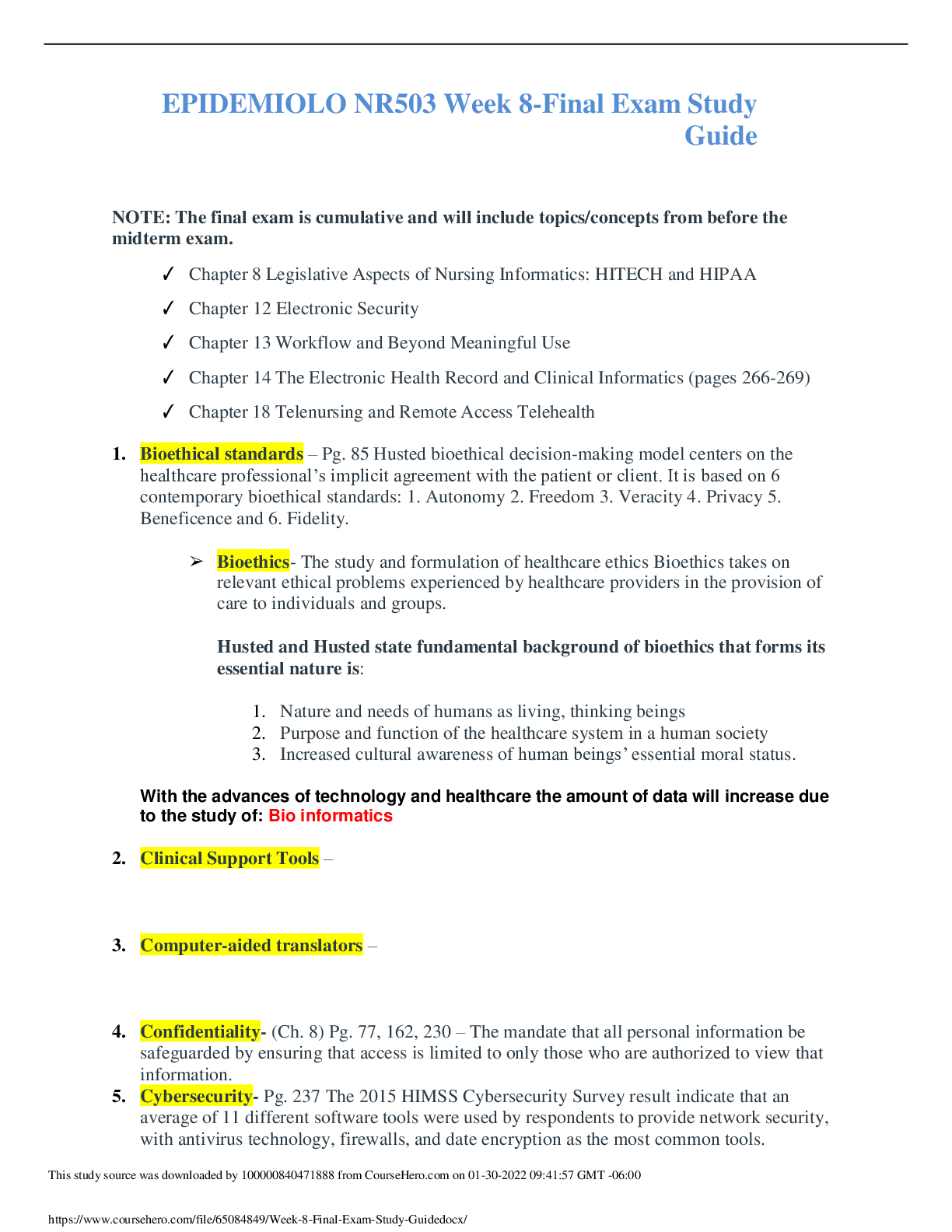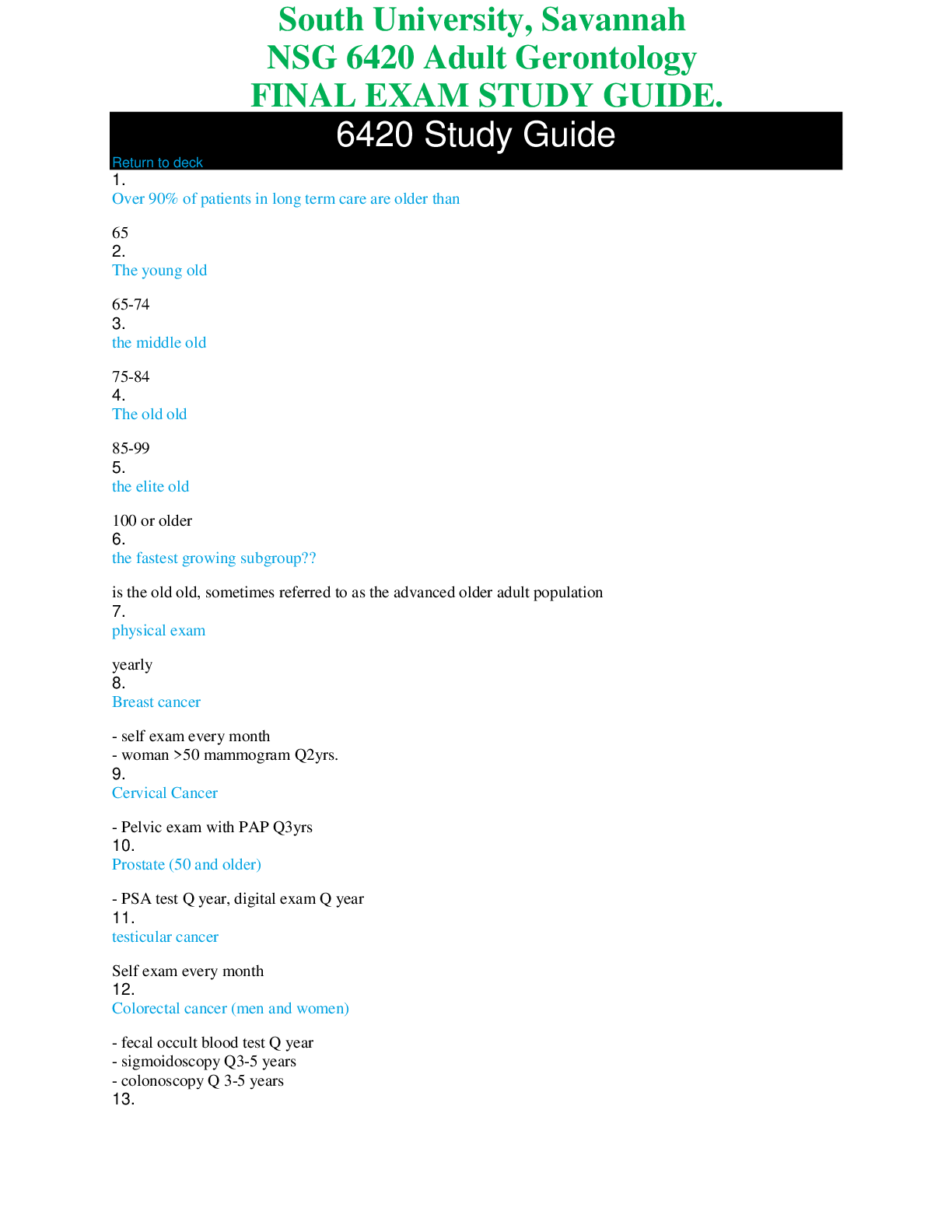*NURSING > STUDY GUIDE > NR 509 Final Exam Study Guide Chamberlain College of Nursing (All)
NR 509 Final Exam Study Guide Chamberlain College of Nursing
Document Content and Description Below
NR 509 Final Exam Study Guide. Chapter 5 Behavior/Mental Health Assessment and Modification for Age Unexplained conditions lasting >6weeks should prompt screening for depression, anxiety, or b... oth PRIME-MD (Primary Care Evaluation of Mental Disorders). 26 questions and take 10 minutes to complete. Used for the 5 most common=anxiety, depression, alcohol, somatoform, and eating disorders. Patient indications for Mental Health Screening: 1.Medically unexplained physical symptoms-more than half have depression and anxiety disorders 2. Multiple physical or somatic symptoms or high symptom count 3.High severity of the presenting somatic symptoms, chronic pain 4.Symptoms for more than 6 weeks 5. Physician rating as a “difficult encounter” 6. Recent stress 7.Low-self rating of overall health 8.Frequent use of health care services 9.Substance abuse. CAGE=substance-related and addictive disorders Modification for Age Elderly: -Complain of memory problems but usually is due to benign forgetfulness -Retrieve and process data more slowly and take longer to learn new information -Slower motor responses and their ability to perform complex task may diminish -Important to distinguish age-related changes from manifestations of mental disorders More susceptible to delirium which can be the first sign of infection, problems with medications, or impending dementia Infant: Assess mental status of a newborn=observing newborn activities 1.Look at human faces and turn to parents voice 2.Ability to shout out repetitive stimuli 3. Bond with caregiver 4.Self-soothe Normal VS. Abnormal Findings and Interpretation Mood disorders: compulsions, obsessions, phobias, and anxieties -Lethargic: drowsy, but open their eyes and look at you, respond to questions, and then fall asleep. -Obtunded: open their eyes and look at you but respond slowly and are somewhat confused. -Agitated depression: crying, pacing, and handwringing -Depression: the hopeless slumped posture and slowed movements. -Grooming and personal hygiene may deteriorate: Depression, schizophrenia, and dementia -Manic Episode: the agitated and expansive movement of a manic episode -Obsessive-Compulsive Disorder: Excessive fastidiousness -Lesion parietal cortex: one side neglect in the opposite parietal cortex, usually in the nondominant side -Parkinsonism: facial immobility -Paranoia: anger, hostility, suspiciousness, or evasiveness -Mania: Elation and euphoria Schizophrenia: flat affect and remoteness Apathy (dull affect with detachment and indifference): dementia, anxiety, and depression Hallucination: schizophrenia, alcohol withdrawal, and systemic toxicity Amnestic Disorders: impaired memory or new learning ability and reduce social or occupational functioning but lack the global features of delirium and or dementia. Anxiety and depression, and intellectual disability may also cause recent memory impairment. Calculating ability: poor performance = dementia or aphasia Variations and abnormalities in thought processes: 1.Circumstantiality: The mildest thought disorder, consisting of speech with unnecessary detail, indirections, and delay in reaching the point. Some topics may have a meaningful connection Occurs in people with obsessions 2. Derailment: Tangential, speech with shifting from topics that are loosely connected or unrelated. The patient is unaware of the lack of association. Schizophrenia, manic episodes, and other psychotic disorders 3.Flight of ideas: an almost continuous flow of accelerated speech with abrupt changes from one topic to the next. Changes are based on understandable associations, play on words, or distracting stimuli, but ideas are not well connected. Manic episodes 4.Neologisms: invented or distorted words, or words with new and highly idiosyncratic meanings -Schizophrenia: psychotic disorders, and aphasia 5.Incoherence: Speech that is incomprehensible and illogical, with lack of meaningful connections, abrupt changes in topic, or disordered grammar or word use. Flight of ideas, when severe, may produce incoherence -Schizophrenia 6.Blocking: Sudden interruption of speech in mid-sentence or before the idea is completed “losing the thought” -Schizophrenia 7.Confabulation: Fabrication of facts or events, to fill in the gaps from impaired memory -Korsakoff syndrome from alcoholism 8.Perseveration: persistent repetition of words or ideas -Schizophrenia or other psychotic disorders 9. Echolalia: Repetition of the words and phrases of others -Manic episodes or Schizo 10.Clanging: Speech with choice of words based on sound, rather than meaning, as in rhyming and punning. Example: “look at my eyes and nose, wise eyes and rosy nose. To to one, the ayes have it!” -Schizo and manic episodes Abnormalities of Perception 1. Illusions: misinterpretations of real external stimuli, such as mistaking rustling leaves for the sounds of voices -Grief, delirium, PTSD, Schizo 2.Hallucinations: Perception-like experiences that seem real but, unlike illusions, lack actual external stimulation. The person may or may not recognize the experiences as false. May be auditory, visual, olfactory, gustatory, tactile, or somatic. -PTSD, Schizo, delirium, dementia, alcoholism Abnormalities of Thought Content 1.Compulsions -repetitive behaviors feel driven to perform in response to an obsession (anxiety disorders) 2.Obessions -Recurrent persistent thoughts, images, or urges 3.Phobias -Persistent irrational thoughts, compelling desire to avoid provoking stimulus 4. Anxieties 5. Feelings of unreality 6.Feelings of Depersonalization 7.Delusions Erotomanic: the belief that another person is in love with the individual Somatic: involves body functions Unspecified: includes delusions of reference without a prominent persecutory or grandiose component Speech Patterns -Slow speech: depression -Accelerated speech: mania -Articulation: are the words clear and distinct: does the speech have a nasal quality -Dysarthria: defective articulation “slurred speech” -Dysphonia: results from impaired volume, quality, or pitch of voice. Difficulty speaking due to a physical disorder of the mouth, tongue, throat, or vocal cords. -Aphasia: the loss of ability to understand (receptive/Wernicke) or express speech (expressive/Broco aphasia) -Brocas aphasia: patients articulate very slowly and with a great deal of effort. Nouns, verbs, important adjectives are usually present and only small grammatical words are dropped from speech "Well…..cat and…..up……..um, well, um…forget it" -Wernicke's aphasia the patient can speak effortlessly and fluently, but his words often make no sense “the coffee cat looks crazy still” -Cerebrovascular infarction -Fluency: fluency reflects the rate, flow, and melody of speech and the content and use of words. Abnormalities -Hesitancies and gaps in the flow and rhythm of words -Disturbed inflections, such as monotone -Circumlocutions: phrases or sentences are substituted for a word the person cannot think of. Example “what you write with for “pen” -Paraphasia: malformed, wrong, or invented Testing for Aphasia -Word comprehension: ask the patient to follow one-stage commands such as “Point to your nose” -Repetition -Naming -Reading comprehension -Writing Mental Status Examination Brief test used to screen for cognitive dysfunction or dementia and follow the patients course over time. Orientation Short-term memory-retention/recall Language Attention Calculation Constructive Praxis Example of findings that suggest dementia: “The patient appears sad and fatigued; clothes are wrinkled. Speech is slow and words are mumbled. Thought processes are coherent, but insight into current life reverses is limited. The patient is oriented to person, place, and time. Digit span, serial 7s, and calculations accurate, but responses delayed. Clock drawing is good. Screening for Depression High Yield Screening Questions for office practice: 1. over the past 2 weeks, have you felt down, depressed, or hopeless? 2. Over the past 2 weeks, have you felt little interest or pleasure in doing things (anhedonia)? Symptoms of depression: low self-esteem, loss of pleasure (anhedonia), sleep disorder, difficulty concentrating. Depression tends to be long-lasting and can recur. Suicide is the second leading cause of death among 15-24-year-old. Suicide rate are the highest among those ages 45 to 54, followed by elderly adults 85 years old or older. 90 % of suicide is non-Hispanic whites. Other symptoms of depression: headaches, muscle aches, fatigue Generalized Anxiety Disorder -Most common mental disorder in primary care -High Yield Screening Questions for office practice: 1. Over the past 2 weeks, have you been feeling nervous, anxious, on edge, unable to stop or control worrying? 2. Over the past 4 weeks, have you had an anxiety attack-suddenly feeling fear or panic? You can screen for core anxiety symptoms by asking the first two questions from the 7-item generalized anxiety disorder (GAD) scale. Scores on this GAD subscale range from 0 to 6; a score of 0 suggests that no anxiety disorder is present. A score of 10 on the GAD-7 identifies GAD; scores of 5, 10, and 15 represent mild, moderate, and severe levels of anxiety. Depressive Disorders Depression and anxiety disorders are a common cause of hospitalization in the United States, and mental illness is associated with increased risks for chronic medical conditions, decreased life expectancy, disability, substance abuse, and suicide. About 19million adult American or almost 7% have major depression with other coexisting anxiety disorder or substance abuse. Depression is as common in women as men, and the prevalence of postpartum depression is about 7% to 13%. Most patients with chronic medical conditions have depression. Symptoms of depression in high-risk patients may be subtle and may include; • Low self-esteem • Loss of pleasure in daily activities (Anhedonia) • Sleep disorder, • Difficulty concentrating or making decisions. Look carefully for symptoms of depression in vulnerable patients, especially those who are young, female, single, divorced or separated, seriously or chronically ill, bereaved, or have other psychiatric disorders, including substance abuse. A personal or family history of depression also places patients at risk. Asking two simple questions about mood and anhedonia appears to be as effective as using more detailed instruments. All positive screening tests warrant full diagnostic interviews. Failure to diagnose depression can have fatal consequences— the presence of an affective disorder is associated with an 11-fold increased risk for suicide. Depression screening • Over the past 2 weeks, have you felt down, depressed, or hopeless? • Over the past 2 weeks, have you felt little interest or pleasure in doing things (anhedonia)? Depression tends to be long-lasting and can recur. Because of these two factors, a wait-and-see approach to treatment is not desirable and timely treatment is necessary. Schizophrenia • Grooming and personal hygiene may deteriorate flat affect and remoteness • Hallucinations: lack actual external stimulation • Derailment: Tangential, speech with shifting from topics that are loosely connected or unrelated. The patient is unaware of the lack of association. • Neologisms: invented or distorted words, or words with new and highly idiosyncratic meaning. • Incoherence: Speech that is incomprehensible and illogical, with lack of meaningful connections, abrupt changes in topic, or disordered grammar or word use. • Flight of ideas, when severe, may produce incoherence • Blocking: Sudden interruption of speech in midsentence or before the idea is completed “losing the thought” • Clanging: speech with choice of words based on sound, not meaning • Echolalia: repetition of the words and phrases • Illusions: misinterpretations of real external stimuli (mistaking rustling leaves for the sound of voices) • Usually occurs in late teens, early 20s (college students, common psych break) • Commonly seen in other family members Suicide Risk and Prevention Protective factors buffer individuals from suicidal thoughts and behavior. To date, protective factors have not been studied as extensively or rigorously as risk factors. Identifying and understanding protective factors are, however, equally as important as researching risk factors. Protective Factors ● Effective clinical care for mental, physical, and substance abuse disorders ● Easy access to a variety of clinical interventions and support for help seeking ● Family and community support (connectedness) ● Support from ongoing medical and mental health care relationships ● Skills in problem solving, conflict resolution, and nonviolent ways of handling disputes Cultural and religious beliefs that discourage suicide and support instincts for self-preservation Suicide is the second leading cause of death among 15- to 24-year olds. Suicide rates are highest among those ages 45 to 54 years, followed by elderly adults ≥age 85 years. Men have suicide rates nearly four times higher than women, though women are three times more likely to attempt suicide. Men are most likely to use firearms to commit suicide, while women are most likely to use poison. Overall, suicides in non-Hispanic whites account for about 90% of all suicides. American Indian/Alaska Native women ages 15 to 24 years have the highest suicide rates of any racial/ethnic group. Substance Use Disorders, Including Alcohol and Prescription Drugs. The harmful interactions between mental disorders and substance use disorders also present a major public health problem. Rates of drug-induced deaths continue to increase and are highest among whites and American Indian/Alaska Natives. The Centers for Disease Control and Prevention reports that prescription drugs have replaced illicit drugs as a leading cause of druginduced deaths. Every patient should be asked about alcohol use, substance abuse, and misuse of prescription drugs Suicide Risk and Prevention Risk Factors ● Family history of suicide ● Family history of child maltreatment ● Previous suicide attempt(s) ● History of mental disorders, particularly clinical depression ● History of alcohol and substance abuse ● Feelings of hopelessness ● Impulsive or aggressive tendencies ● Cultural and religious beliefs (e.g., belief that suicide is noble resolution of a personal dilemma) ● Local epidemics of suicide ● Isolation, a feeling of being cut off from other people ● Barriers to accessing mental health treatment ● Loss (relational, social, work, or financial) ● Physical illness ● Easy access to lethal methods ● Unwillingness to seek help because of the stigma attached to mental health and substance abuse disorders or to suicidal thoughts Chapter 9 & 12 Cardiac/Vascular Assessment and Modification for Age Normal VS. Abnormal Findings and Interpretation -Acute aortic dissection: anteri [Show More]
Last updated: 1 year ago
Preview 1 out of 52 pages
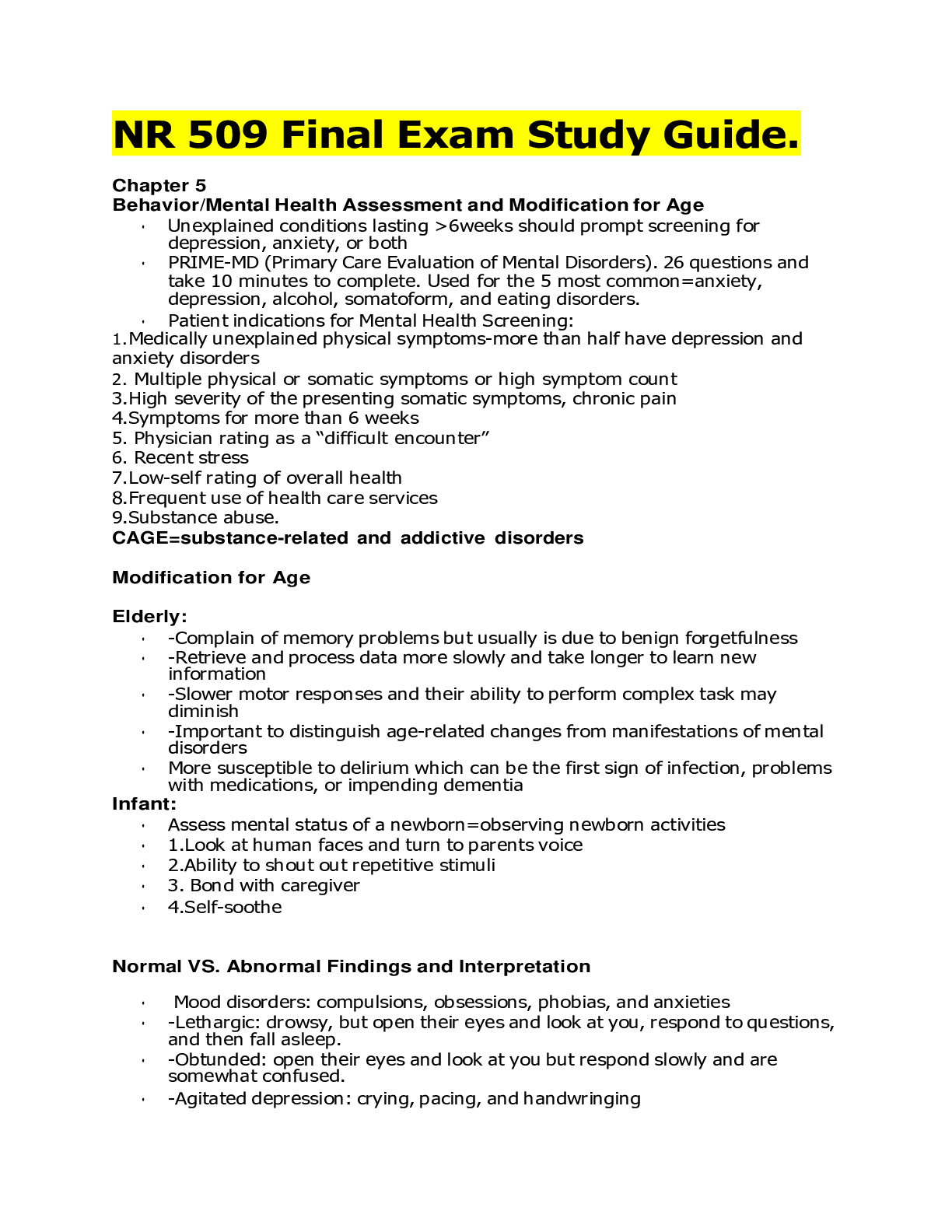
Reviews( 0 )
Document information
Connected school, study & course
About the document
Uploaded On
Apr 25, 2022
Number of pages
52
Written in
Additional information
This document has been written for:
Uploaded
Apr 25, 2022
Downloads
0
Views
101



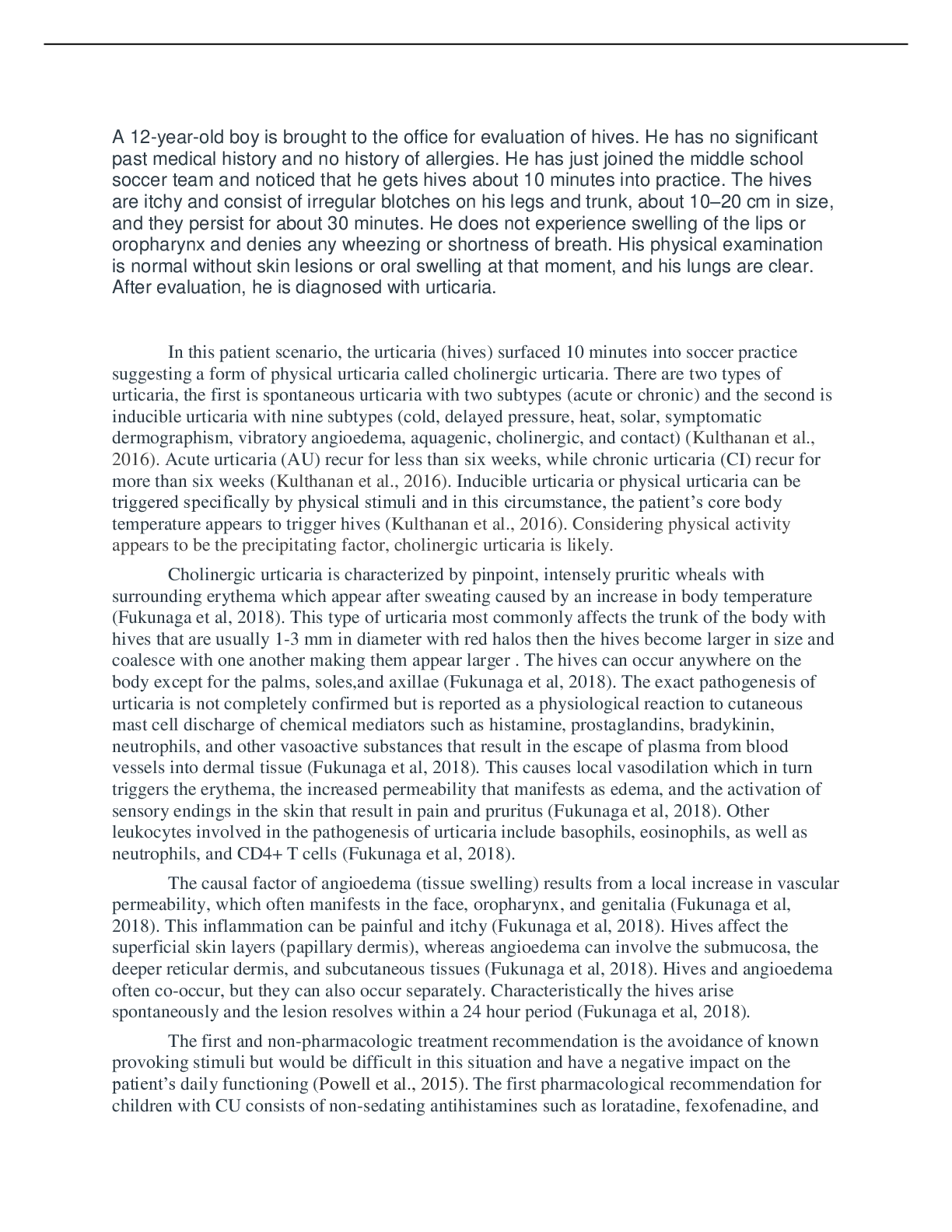
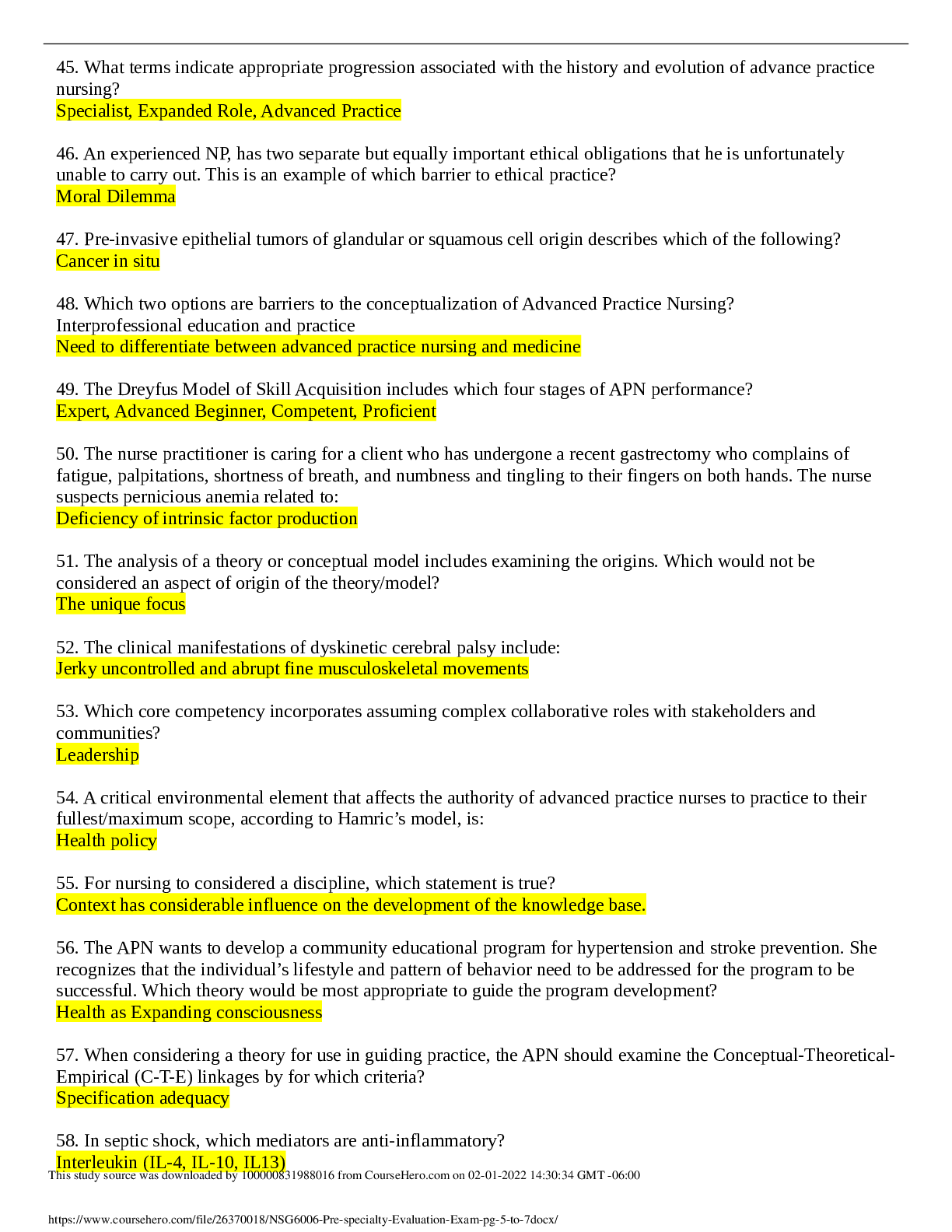





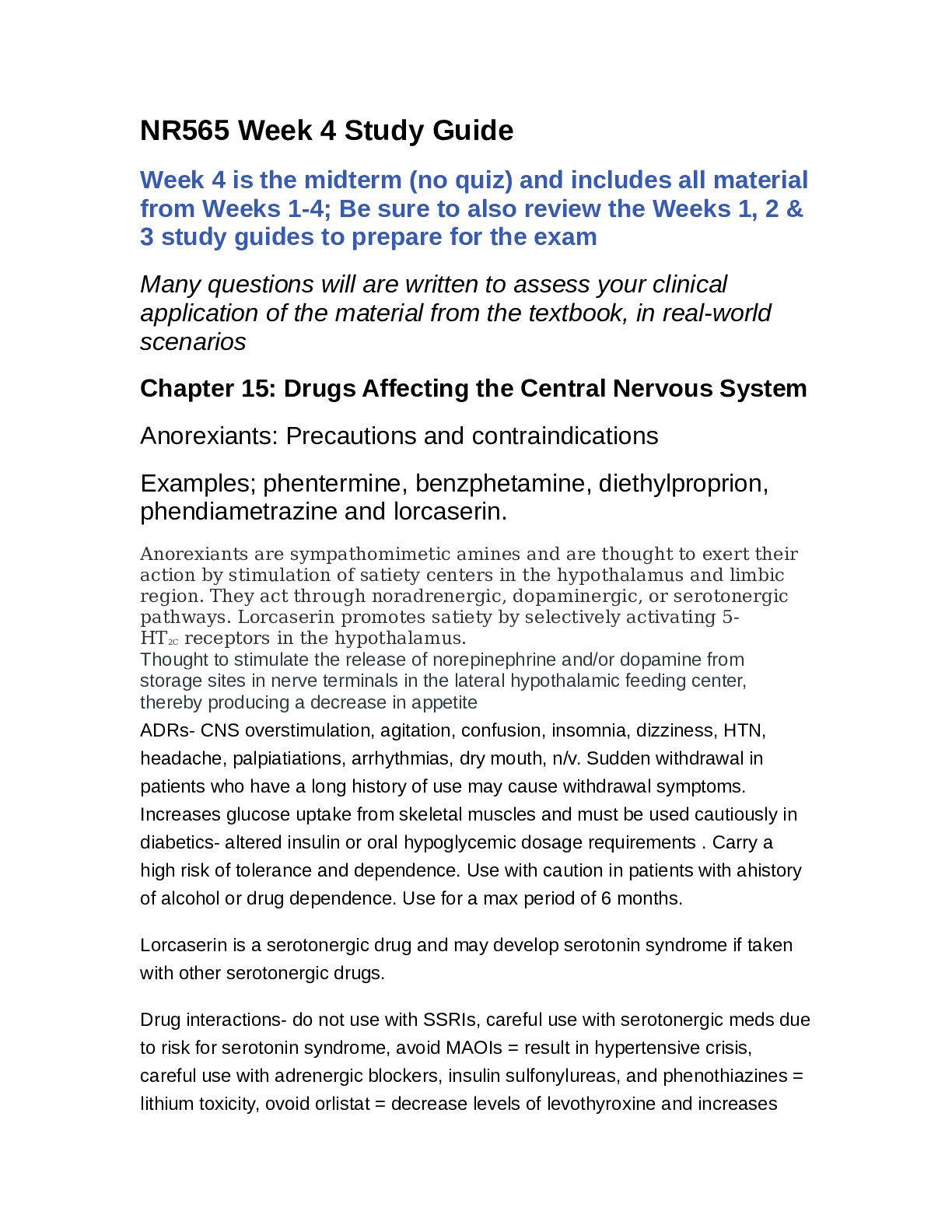
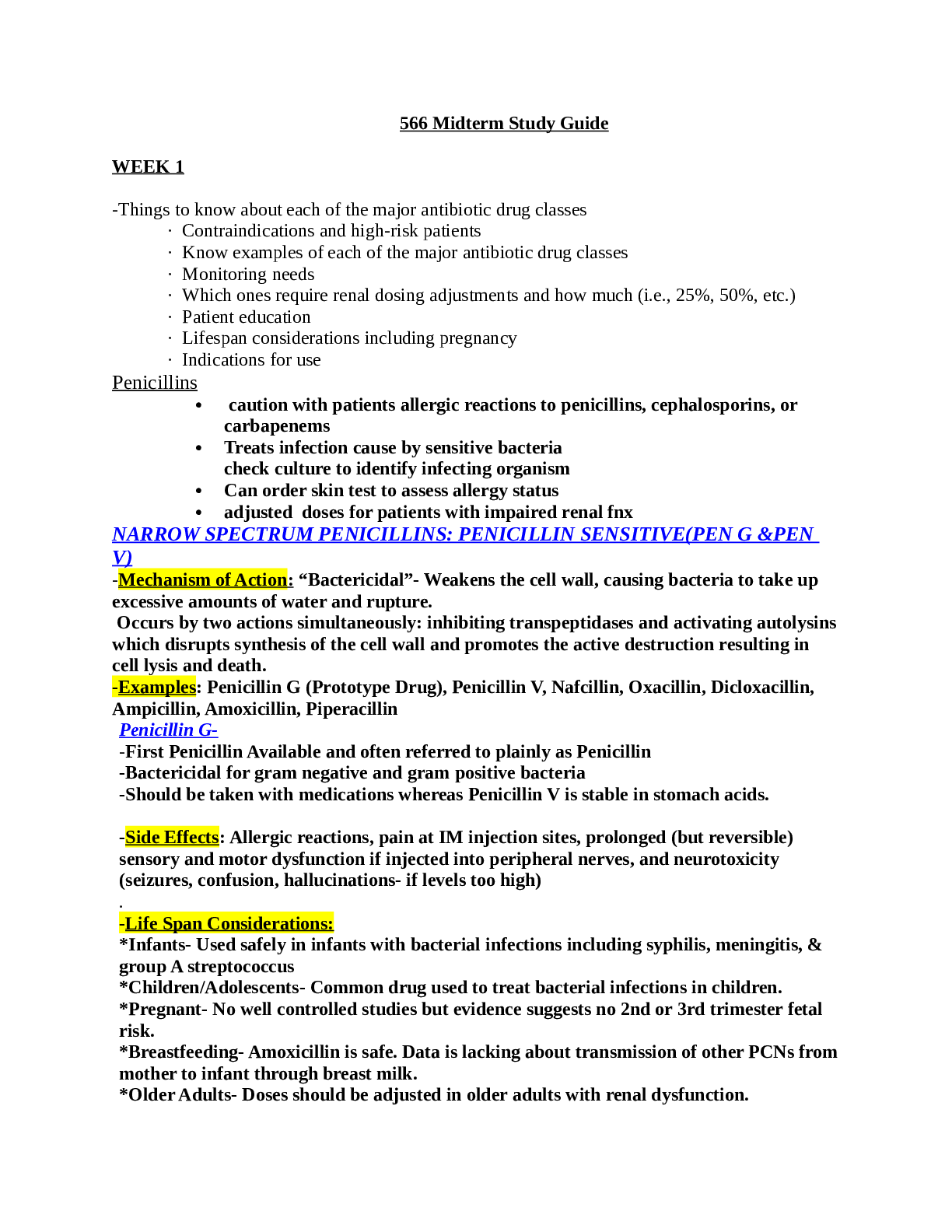


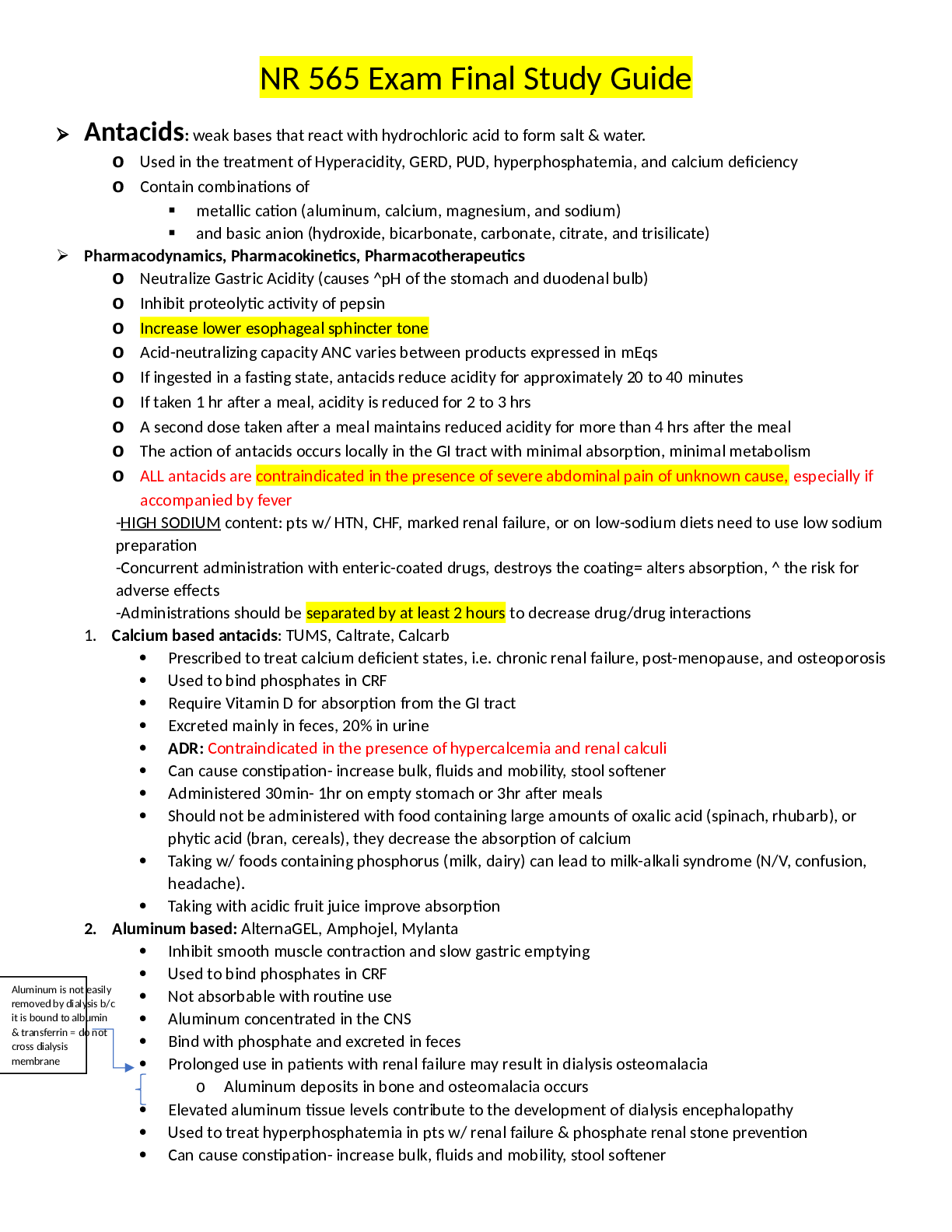
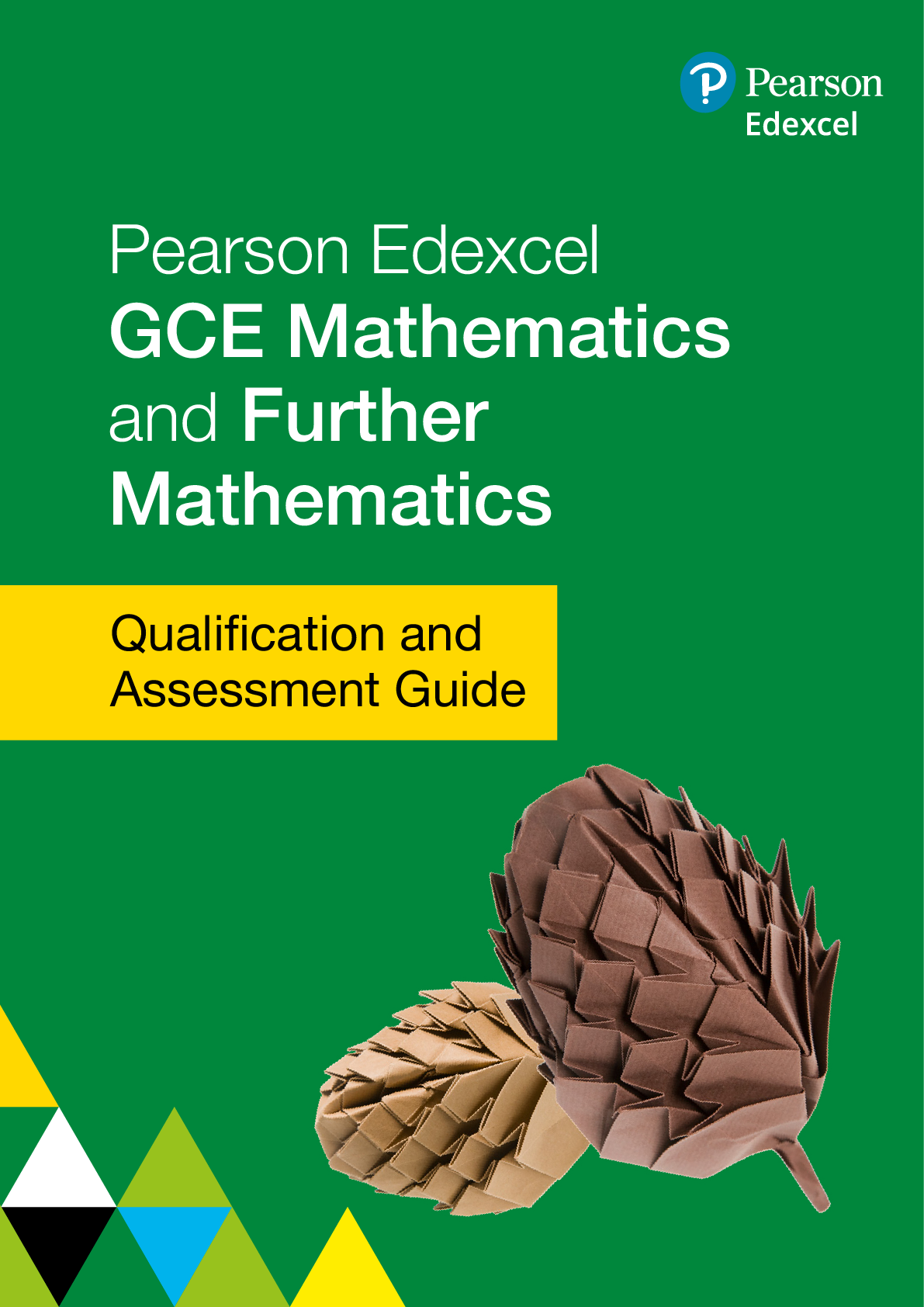





 Rasmussen College.png)
